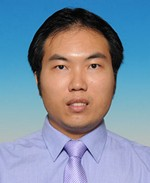
Keynote Speakers
Associate Prof. Cheng Li
Changchun Institute of Technology/ School of energy and power engineering

Brief introduction: Dr. Cheng Li is an associate professor, master tutor of Changchun Institute of Technology, doctor and post-doctor of British overseas returnees, and a core member of "National and Local Joint Engineering Research Center of Intelligent Distribution Network Measurement and Control and Safe Operation Technology," deputy director of Energy and Power Engineering Department. In 2020, he was selected as the "Fourth Batch of Jilin Province Young Science and Technology Talents Promotion Project" and won the second prize of the Jilin Province Science and Technology Progress Award in 2021. In 2021, he participated in the critical research and development project of The Ministry of Science and Technology, "Key Technology Research of horizontal axis Tidal Energy Generator Set of 100 kilowatts," as a core member. In the past five years, he has published 11 SCI papers, 6 EI retrieval papers, 2 authorized invention patents and 5 utility model patents, among which 4 patents have been transformed into achievements, achieving economic benefits of more than 12 million yuan. The main research areas are hydropower generation, transmission, distribution and transformation of power operation and maintenance, materials science and application.
Speech Title:
Research on operating state sensing technology of insulators in transmission and distribution lines based on linear variable spectroscopy
Abstract:
The voltage level of the transmission line is high, and the environment of the line corridor is complex. The insulator has been in the outdoor open environment for a long time, and is infested by industrial pollution, rain, snow, frost, floating dust, smog, sandstorm, salt spray, etc., and its surface pollution is accumulating day by day. The electrical insulation problem under certain conditions seriously affects the normal operation of the power system. In recent years, pollution flashover accidents of transmission line insulators due to external insulation pollution have occurred from time to time, which may reduce the safe and stable operation margin of the power grid, and cause large-scale power outages in severe cases. social and economic issues. Insulator pollution has become one of the most important factors in determining the insulation level of transmission lines and the safe and stable operation of power grids. Existing detection methods for the running state of insulators in transmission and distribution lines, especially pollution and salt density, all have the disadvantages of single detection index and high detection cost. Traditional detection methods require a lot of manpower and material resources, and have certain limitations, making it difficult to realize transmission lines. Live detection of insulator contamination state. The subject uses microwave plasma-assisted pulse sputtering to prepare high linearity graded spectroscopic filters, develops a multi-channel contamination collection device with resistance to strong electric field interference, and changes the traditional narrow wavelength range single target detection method through hyperspectral spectroscopy technology of graded filter films , to realize the detection of electrified pollution of the insulation part of power equipment and the troubleshooting of hidden troubles.
Associate Prof. Bernard Saw Lip Huat
Department of Mechanical and Material Engineering, Universiti Tunku Abdul Rahman

Brief introduction: Dr. Bernard Saw Lip Huat is currently an associate professor and chairperson for the Centre for Sustainable Mobility Technologies in the Universiti Tunku Abdul Rahman (UTAR), Malaysia. He received his Ph.D. degree from National University of Singapore (NUS) in 2015. Besides, he is a Chartered Engineer registered with the Engineering Council (UK). His research interests include renewable energy, thermal management, energy storage system, computational fluid dynamic, electrochemical modelling and ventilation. He has co-authored more than 90 peer-reviewed papers in prestigious international journals and won 28 awards in the local and international competitions. He is serving as editorial member and guest editor of several international journals such as Sustainability, Frontiers in Energy Research, Journal of Renewable Materials, Energy Engineering, Fluid dynamic and material processing, Frontiers in Sustainable Resource Management, etc.
Speech Title:
Aluminum-air battery: A green technology for sustainable power generation via circular economy approach
Abstract: Electric vehicles are gaining attention globally due to their capabilities of replacing internal combustion engines that use fossil fuels as an energy source. In the electric vehicle, lithium-ion battery is a popular choice in the market due to its high-power density. Besides, it is green, clean and produces less pollution. However, the development of lithium-ion batteries has reached its peak and the performance is limited based on current technology. In addition, lithium-ion batteries are prone to thermal runaway due to their narrow operating temperature range. Furthermore, disposal of lithium-ion batteries is one of the important issues that remain unsolved as there is no consensus on proper disposal or recycling method. Hence, there is a need to introduce alternative energy sources to reduce the environmental impact. Metal-air battery is a promising candidate as it has a high theoretical energy density which is an ideal candidate to enhance the driving distance of the electric vehicle. Metal-air batteries required air and a metal anode to generate electricity. The design is simple and produces less end-product as compared to lithium-ion batteries. In general, most of the end-product of metal-air batteries is its corresponding metal oxide which can be recycled or processed into secondary products. In this talk, the architecture of the aluminum-air battery, factors affecting the aluminum-air battery performance, challenges of the aluminum-air battery will be presented.